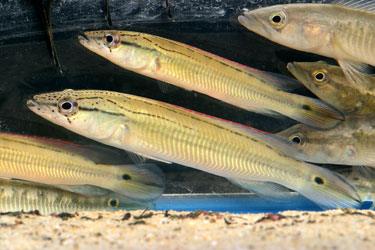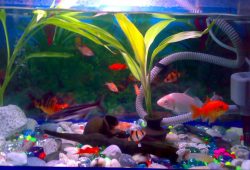Frequently asked questions on Pike cichlids
This article is about Frequently asked questions on Pike cichlids.

Contents
Will pike cichlids eat smaller fish?
Yes, most Crenicichla species are adapted to eat smaller fish species, which make up much of their diet in the wild. If given the opportunity, they will eat smaller fish in captivity. They are, however, safe to be kept with fish that are too large to swallow.
What other species of fish can be kept?
Despite a fearsome reputation for being very aggressive, pikes are no less accommodating than an Oscar and will live alongside other fish without many problems.
Smaller species like C. regani and C. compressiceps are OK with larger tetras like Black widows, Bleeding hearts tetras and Columbian red fins tetras.
The larger species, 15cm/6″ and over, are OK with larger characins like Silver dollars, Chalceus and Flag tail prochilodus, as well as large, peaceful species of barb like Tinfoils.
Catfish can be mixed with all pike cichlid species – anything from Corydoras are suitable tankmates for the dwarf species, while large, armoured plecs and doradiids and Synodontis are suitable tankmates for the larger species.
To avoid unnecessary conflict, don’t add too many other cichlid species as these will be seen as competition for food and territory. Ensure that the body shape is different to that of the pikes, so choose Severums, Heros spp. or Uaru like amphiacanthoides, – two species with a high body profile and large eventual size.
What should a pike cichlid set-up consist of?
These elongate cichlids are mainly bottom dwelling, so a tank that is wide and long rather than tall is better. Filtration should consist of strong power filters filled with plenty of mechanical and biological media to cope with the rich waste produced by these predatory fish.
Lighting should be subdued. One fluorescent light tube for any size tank should suffice.
The decor should consist of bogwood, rocks and caves to provide hiding places. Any combination of real and imitation logs and caves can be used.
Decorate in such a way so as to provide at least one hiding place per pike to keep them happy.
Planting can consist of crypts, Amazon sword plants, Vallisneria and Anubias for the dwarf species, but for the larger species, use plastic plants, tough Java ferns tied to decoration, or none at all! To produce soft acidic water conditions, RO water is the best option.
What species of pike should I choose?
Crenicichla is a massively under-represented group of cichlids in the hobby, and only about 15 species out of 80 or so are regularly seen.
What species you choose will firstly be governed by the size of the tank that you can offer. If the tank length is 90cm/36″ or less, you must only keep the dwarf species – C. regani, C. notophthalmus and C. compressiceps – but don’t be put off because these have all the appeal, and even more charm, than the larger species.
For a tank of 120cm/ 48″ x 38-45cm/15-18″, the saxatilis-group is the most suitable. Look out for C. lepidota, C. menezesi and C. saxatilis, but you could also look out for something rarer like C. jurubi, a fish I imported from Uruguay in 2003.
And finally, for tanks of 180 x 90 x 60cm/6′ x 24″ x 24″, the larger fish from the C. lugubris group can be kept including C. sp. Xingu I, the Orange pike cichlid, and C. marmorata, the Marbled pike cichlid, both great favourites of mine as they possess loads of character and colour.
Can pike cichlids be bred in captivity?
Yes, but they are by no means easy to breed, and it would need a special effort by the owner.
Firstly, you need to obtain a pair, so buy six young individuals and hope for the best. Most are sexually dichromatic, meaning that there are differences between males and females in their markings and colour.
Females tend to develop a red belly, and in the saxatilis-group, a group that includes many of the stereotypical-looking pike cichlids, males have much more iridescent speckling and longer fins.
When a pair forms, it can be quite a violent affair. The female fish is the main instigator of the courtship and takes over a territory that will contain
a potential spawning site.
The remainder of the group and any other fish in the tank are best removed, as potential egg/fry eaters will be harassed to the point of being mauled if they cannot get out of the way.
Observe the newly formed pair closely over the following days; even long-established pairs can divorce and start to fight.
To induce spawning, feed plenty of protein-rich foods like whitebait and cockles, and krill for the smaller species. All species will naturally condition better in water with a
pH of around 6 and a temperature of 26°C/79°F.
Suitable spawning sites include bogwood with a shallow pit dug underneath it and pieces of PVC pipe. Offer several potential spawning sites for best results.
Egg number will differ from species to species, and there are reports that the first spawning may carry a high number of infertile eggs. Fry can take up to seven days to become free swimming and will be cared for by both parents for months.



